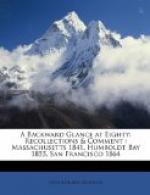Checker-board street planning was a serious misfortune to the city, and it was aggravated by the narrowness of most of the streets. Kearny Street, forty-five and one-half feet wide, and Dupont, forty-four and one-half feet, were absurd. In 1865 steps were taken to add thirty feet to the west side of Kearny. In 1866 the work was done, and it proved a great success. The cost was five hundred and seventy-nine thousand dollars, and the addition to the value of the property was not less than four million dollars. When the work began the front-foot value at the northern end was double that at Market Street. Today the value at Market Street is more than five times that at Broadway.
The first Sunday after my arrival in San Francisco I went to the Unitarian church and heard the wonderfully attractive and satisfying Dr. Bellows, temporary supply. It was the beginning of a church connection that still continues and to which I owe more than I can express.
Dr. Bellows had endeared himself to the community by his warm appreciation of their liberal support of the Sanitary Commission during the Civil War. The interchange of messages between him in New York and Starr King in San Francisco had been stimulating and effective. When the work was concluded it was found that California had furnished one-fourth of the $4,800,000 expended. Governor Low headed the San Francisco committee. The Pacific Coast, with a population of half a million, supplied one-third of all the money spent by this forerunner of the Red Cross. The other states of the Union, with a population of about thirty-two million, supplied two-thirds. But California was far away and it was not thought wise to drain the West of its loyal forces, and we ought to have given freely of our money. In all, quite a number found their way to the fighting front. A friend of mine went to the wharf to see Lieutenant Sheridan, late of Oregon, embark for the East and active service. Sheridan was grimly in earnest, and remarked: “I’ll come back a captain or I’ll not come back at all.” When he did come back it was with the rank of lieutenant-general.
While San Francisco was unquestionably loyal, there were not a few Southern sympathizers, and loyalists were prepared for trouble. I soon discovered that a secret Union League was active and vigilant. Weekly meetings for drill were held in the pavilion in Union Square, admission being by password only. I promptly joined. The regimental commander was Martin J. Burke, chief of police. My company commander was George T. Knox, a prominent notary public. I also joined the militia, choosing the State Guard, Captain Dawes, which drilled weekly in the armory in Market Street opposite Dupont. Fellow members were Horace Davis and his brother George, Charles W. Wendte (now an eastern D.D.), Samuel L. Cutter, Fred Glimmer of the Unitarian church, Henry Michaels, and W.W. Henry, father of the present president of Mills College. Our active service was mainly confined to marching over the cruel cobble-stones on the Fourth of July and other show-off occasions, while commonly we indulged in an annual excursion and target practice in the wilds of Alameda.




